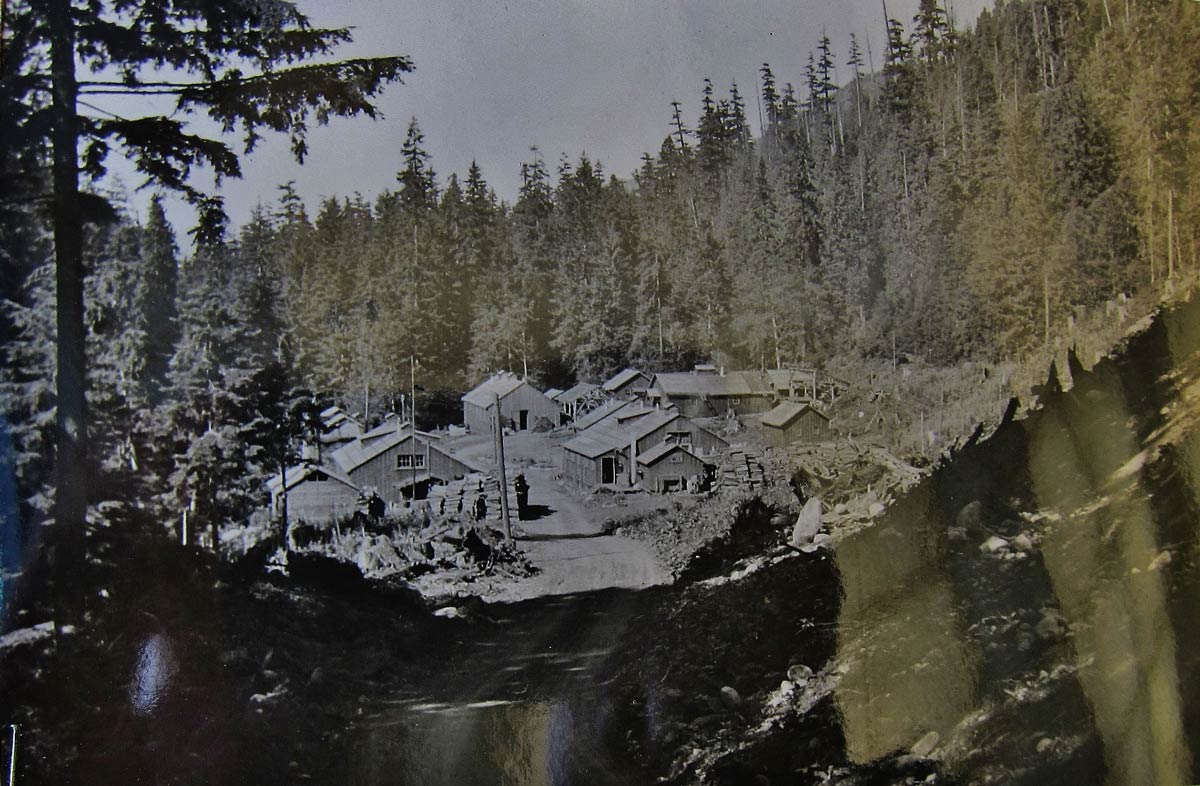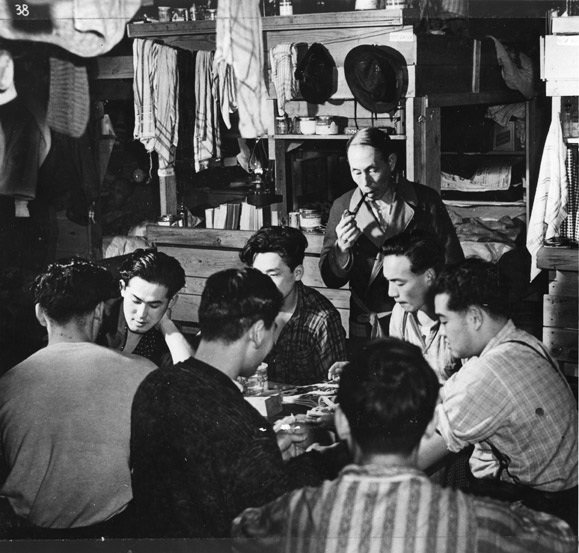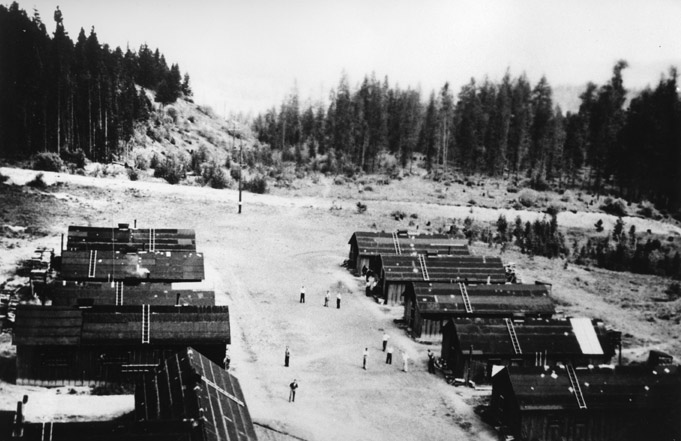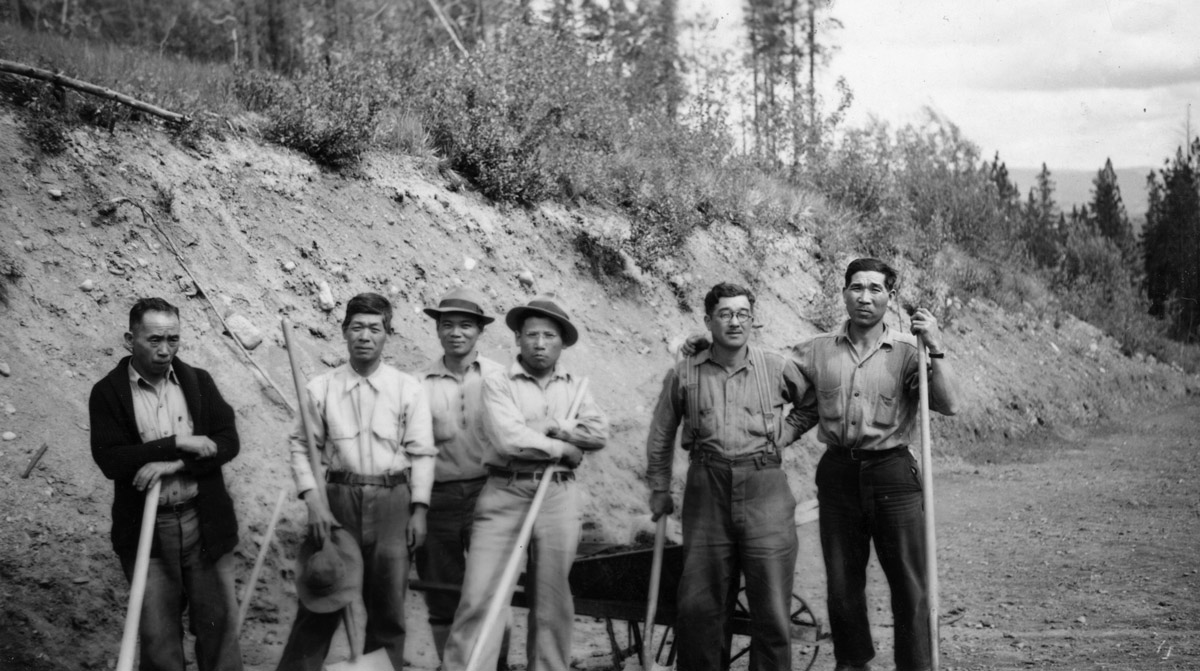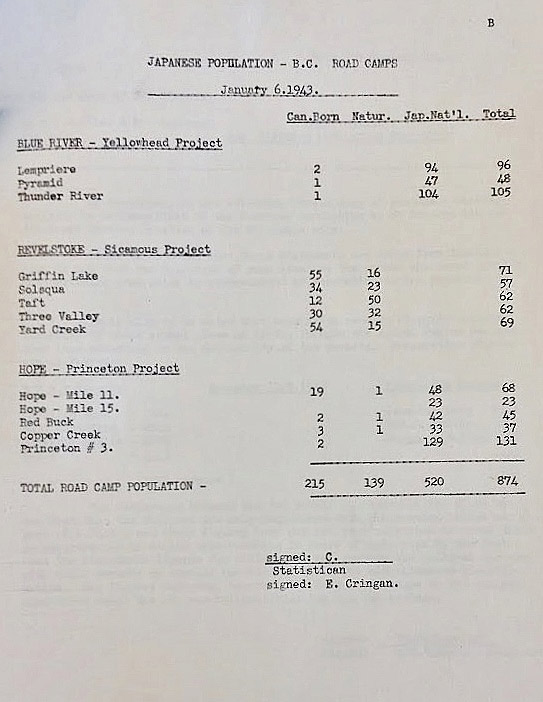The Hope Princeton Project road camps were part of a number of road camps that were established for Japanese single and married men following the order to evacuate the Japanese from the 100 mile protected zone in BC. This separation of the men from their families was a major point of contention during the early part of the evacuation. A detailed description of all of the road camps is given in The Exiles – An Archival History of the World War II Japanese Road Camps, Yon Shimizu, 1993.
There were six road camps along the Hope Princeton highway project. These were: Hope – Mile 11, Hope – Mile 15, Camp No 1 Red Buck (Princeton #1), Camp No 5 Copper Creek (Princeton #2), Camp No 2 or Princeton #3 and Summit Camp No 4. Only Hope-Mile 11 and Hope-Mile 15 were under the supervision of the Commission Supervisor of Tashme.
Mile 11
Located on the road from Hope to Tashme, 3 miles from Tashme, the Mile 11 road camp was opened on March 15, 1942. In January 1943, about 70 men were employed in road construction. 16 married men had families in Tashme. These men were permitted weekly visits with their families. There were two dormitories, a kitchen and dining hall, and a Japanese bath house.
Mile 15
Located about 1 mile or about 20 minutes walk from Tashme, Mile 15 road camp employed 13 married and 10 single Japanese men for a total of 23 as of January 1943.
Red Buck (Camp No 1)
This camp was located 59 miles east and north of Tashme or 11 miles southwest of Princeton. (Princeton was located 70 miles east of Tashme.) In January 1943, this camp employed 45 men
Copper Creek (Camp No 2)
Copper Creek was located 41 miles east and north of Tashme or 29 miles southwest of Princeton and employed 76 in July 1942, and 37 in January 1943.
Princeton (Camp No 5)
Located 53 miles east and north of Tashme or 17 miles southwest of Princeton, this camp employed 52 men in July 1942 and 131 in January 1943.
As of January 1943, there were 874 men employed at the four Princeton Project road camps.
Summit Camp (Camp No 4)
Located 50 miles southwest of Princeton near Allison Pass, the highest point on the Hope Princeton highway, this camp was the last and latest camp to be constructed.
Friday Creek (Camp No 5)
Located 13 miles south of Princeton, this camp served as a base camp.
Road construction was slow at first due to a lack of heavy equipment. The work of the men was mainly hard manual labour, 8 hours per day, 5 days a week. The men worked 8 hours per day. The pay was 25 cents per hour for labour, 30 cents for blacksmiths, saw filers, etc, 35 cents for carpenters with their own tools, and foremen, and 40 cents for teamsters. 75 cents per day is deducted for board and lodging and $1.00 per month for medical care. In addition, there were cooks, firemen, and cleaners in each camp.
Working 8 hours per day 5 days a week left the men with many non working hours under conditions of isolation, loneliness and confinement. The Japanese men at these camps organized themselves. A camp co-op store was formed at Hope 11 mile camp in June 1942 with permission of the authorities. Each man was a shareholder and any profit was used for welfare. There were 2 bunkhouses for 100 men, a mess house, a bath house and washing facilities. For recreation, the men read newspapers, wrote letters and listened to the radio. With the decision to unite the men with their families, the Tashme internment camp was established on land rented from A. B. Trites farm 14 miles from Hope to house the men and their families.
In July 1942, a rough road was passable from Princeton to Allison Summit 47 miles from Princeton and 23 miles from Hope towards Princeton. The unfinished distance was estimated at 13 miles.
By August 1942 there were 4 camps at the Princeton end. No 1 camp had more than 60 mostly single men. Married men were sent to the Hope camps to be close to their families who were beginning to arrive from Hastings Park. At the same time 200 men were in working in Tashme constructing the houses.
After work or on weekends the men tended gardens, collected rocks or wood from Juniper tree from which they crafted beautiful boxes and brooches. Others were artists, sculptors, writers and poets. Sports like baseball, hiking and skating were encouraged. However, Japanese were barred from fishing for recreation. Monotony and loneliness were constant hardships.
Beginning in 1943, authorities allowed the men to apply for leaves from the camps to visit families and friends in the interior camps to maintain morale.
The Japanese men in the Princeton camps were permitted to travel to the town of Princeton once per month for activities like movies subject to application and permits.
In September 1943 a three-team baseball league was in operation in Princeton.
In October 1943, the two sections of the Hope Princeton road were linked at Skagit Bluffs located at Mile 26 from Hope. Men from Hope Mile 25 camp greeted men from Princeton No 4 camp through the last gap to car travel on October 6. The road was from 8 to 12 feet wide and barely passable by car.
Construction continued to improve and extend the completed sections of the highway until the project was closed down in September 1945. There were 50 miles passable from Princeton to Allison Summit and from the Hope end there were 7 miles graded and surfaced and 14 miles partly graded between Hope and Tashme.
The following report shows the BC Road Camps on the Hope-Princeton Project Road Camps Near Tashme. Summit Camp No 4 did not exist at the time of this report.


